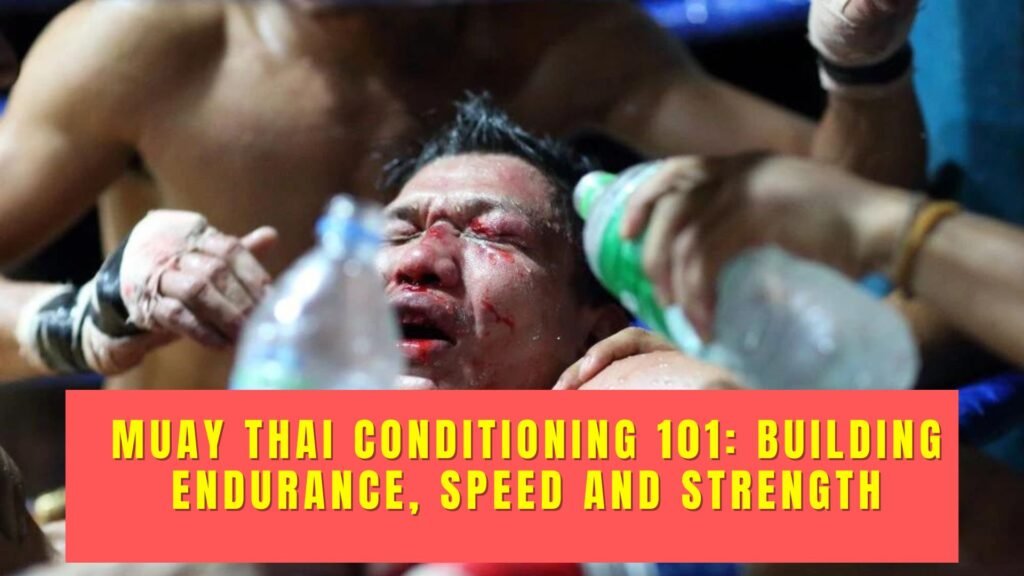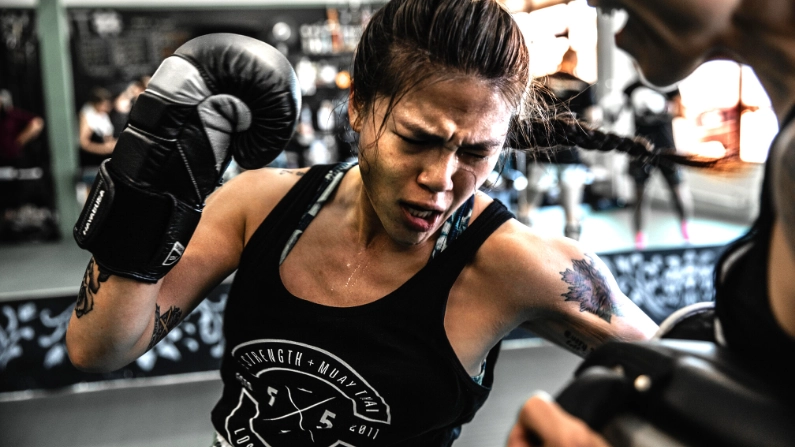Muay Thai is quickly growing into one of the most popular combat sports due to its incorporation of striking as well as clinching in dynamic combinations. However, with the intense conditioning, heavy bag work, sparring sessions and competition bouts also comes a higher risk of injury.

While minor bumps and bruises are often unavoidable, it’s important for fighters to implement preventative measures to protect long-term health and prolong their time in the sport. This guide will overview the most common Muay Thai injuries and provide tips on how to best prevent them. Implementing even a few of these prevention strategies can go a long way in keeping joints stable, bones unbroken, and concussions to a minimum.
Contents
Most Common Muay Thai Injuries and How to Prevent Them
The frequency and severity of injuries can vary greatly depending on factors like training methods, sparring intensity, and competition level. However, the areas most often affected include:
- Head and neck
- Hands and wrists
- Knees, shins and ankles
- Shoulders
While beginners tend to suffer more from minor sprains, strains and contusions, veterans are more prone to serious injuries like fractures, dislocations and spinal injuries from years of wear and tear. No matter what your level, it’s crucial to listen to warning signs from your body and address compromised areas.
Head and Neck Injuries
Due to the dynamic nature of Muay Thai, head and neck trauma is extremely common. Preventing concussions and other damage must be a top priority.
Concussions
- Caused by: Head kicks, knees, elbow strikes, punches, or hitting the canvas
- Symptoms: Headaches, dizziness, nausea, confusion, loss of consciousness
- Treatment: Physical and cognitive rest until symptoms subside
- Prevention Tips:
- Develop strong neck muscles
- Perfect blocking techniques
- Spar at appropriate intensity levels
- Wear headgear when suitable
- Learn correct falling methods
An estimated 15-30% of Muay Thai fighters suffer a concussion each year. While most concussions are mild, repeated head trauma can cause severe issues like memory loss and dementia later in life. Take all head shots seriously and seek medical attention for severe symptoms or after repeated concussions.
Broken Noses
- Caused by: Knees, kicks, elbows or punches to the face
- Symptoms: Pain, swelling, bruising, crookedness, difficulty breathing
- Treatment: Reset the bones, surgery if severely displaced
- Prevention Tips:
- Strengthen neck muscles
- Perfect defense and footwork
- Wear protective face mask or headgear
- Consider nasal strips to protect cartilage
One study showed over 60% of competitive fighters experienced nasal trauma. While not typically severe, facial injuries require lengthy healing and could alter breathing long-term. Face shields and strengthening neck muscles helps reduce impact.
Cauliflower Ear
- Caused by: Blunt trauma that separates ear cartilage from lining
- Symptoms: Swelling, bruising, misshapen ears, possible drainage or crusting
- Treatment: Drain fluid, wrap and splint ear
- Prevention Tips:
- Wear wrestling-style headgear
- Apply protective ear guards
- Tape ears if prior injury exists
Roughly 80% of elite Muay Thai athletes develop unsightly cauliflower ear at some point. Once the cartilage separates, the damage cannot be reversed. Quick prevention measures are key before permanent disfiguration sets in.

Hand and Wrist Injuries
After the head and neck, hands and wrists often sustain the most abuse. From wrapping hands daily to endless heavy bag work, this area breaks down from overuse.
Boxer’s Fractures
- Caused by: Punching with poor technique or misaligned hands
- Symptoms: Pain, swelling, bruising, deformity in hand
- Treatment: Splinting, surgery if severe displacement
- Prevention Tips:
- Perfect punching technique
- Properly wrap hands for support & alignment
- Strengthen wrist and forearms
- Use bag gloves to prevent abrasions
Studies indicate boxers and Muay Thai fighters suffer metacarpal fractures at a rate of 70 per 1,000 athlete-exposures. These small bones cannot withstand the heavy-duty punching without proper conditioning and technique.
Sprains & Strains
- Caused by: Punching or blocking kicks incorrectly, poor flexibility
- Symptoms: Pain, instability, swelling, inflammation
- Treatment: RICE method (Rest, Ice, Compression, Elevation)
- Prevention Tips:
- Warm up wrists thoroughly
- Wrap hands to support joints
- Develop wrist stability & punching form
- Ice after training sessions
Fighters often develop minor sprains and strains from overuse. Wrapping hands tightly supports joints during impact. Take time to warm up tendons before intense sessions.
Leg, Knee and Ankle Injuries
Throwing thousands of kicks alongside countless knee strikes will inevitably take a toll on lower bodies. Common injuries range from annoying to potentially surgery-requiring.
ACL/PCL Tears
- Caused by: Twisting knee forcefully, landing badly from kicks
- Symptoms: Instability, popping sound, swelling & pain
- Treatment: RICE initially, likely surgical reconstruction
- Prevention Tips:
- Strengthen legs with resistance training
- Enhance balance and proprioception
- Warm up properly before fights or hard sparring
- Wear knee braces if prior injury exists
Knee injury rates for Muay Thai fighters have been cited from anywhere between 11.7% to a troubling 31.6% in recent studies. These joint dislocations nearly always necessitate surgery and lengthy rehab. Priority should be placed on leg strengthening and balance training.
Shin Splints
- Caused by: Constant kicking impact without sufficient bone density
- Symptoms: Swelling along shin bone, pain with walking
- Treatment: Rest, ice, anti-inflammatory meds
- Prevention Tips:
- Slowly develop shin conditioning
- Do not strike heavy bags or pads without wraps, shin guards
- If bone pain, take time fully heal
Some fighters feel shin splints are an unavoidable rite of passage. However, training through severe medial tibial pain leads to chronic issues long-term. Allow 12-18 months slowly develop bone density through association methods before impact.
Ankle Sprains
- Caused by: Rolling ankle suddenly, landing unevenly
- Symptoms: Instability, swelling, bruising around ankle
- Treatment: RICE, physical therapy exercises
- Prevention Tips:
- Tape or brace ankles during training
- Improve balance board work
- Enhance proprioception & coordination
- Wear ankle-supporting shoes or wrestling boots
Ankle sprains account for a large percentage of minor injuries during fights. The sudden impacts from kicks or falling over twist ankles into vulnerable positions. Using preventative taping provides essential reinforcement for swimmers and hypermobility.
Shoulder Injuries
While less common than legs and wrists during fights itself, shoulders sustain heavy wear-and-tear from intense training demands.
Dislocations
- Caused by: Direct blows to joint, falling hard on shoulder
- Symptoms: Intense pain, swelling, deformity, inability to move arm
- Treatment: Reset shoulder, likely surgery for repeat dislocations
- Prevention Tips:
- Strengthen rotator cuff muscle group
- Enhance proprioception in shoulder
- Learn correct falling methods
- Tape unstable shoulders during sparring
Research indicates up to 8% of Muay Thai fighters experience shoulder dislocations. Once muscles become stretched from the impact, it tends to keep recurring. Focused strengthening prevents initial dislodging.
Rotator Cuff Strains
- Caused by: Overuse from heavy bag, pads & clinching
- Symptoms: Pain radiating from shoulder joint
- Treatment: Rest, NSAIDs medication, physical therapy
- Prevention Tips:
- Do not overtrain shoulder without adequate recovery
- Perform rotator cuff prehab exercises
- Alternate intensity between striking days
The repetitive motion of long rounds pounding bags and mitts works the shoulder joint excessively. Prehab shoulder conditioning prepares connective tissue for handling heavy loads.
Chronic Injuries & Long-Term Damage
While the acute injuries above often heal fully with proper rest and rehabilitation, fighters must also be cognizant of chronic issues that linger for months or years.
Recognizing Overtraining Signals
If not managed properly, the intense demands of Muay Thai training will eventually cause the body to break down with tell-tale warning signs:
- Constant fatigue & muscle soreness
- Frequent illnesses
- Insomnia or restless sleep
- Failing to achieve personal bests
- Decreased performance during fights
- Lack of motivation for training
- Moodiness, irritability, depression
Learning to balance adequate rest and recovery is imperative. Use easy active recovery sessions, massage, and stress reduction to help the body rejuvenate between challenging workouts.
Preventing Long-Term Brain Trauma
Sub-concussive blows in Muay Thai gradually cause permanent structural changes in the brain over time:
- Reduced gray and white matter
- Shrinking of hippocampus, involved with memory
- Expansion of ventricles filled with cerebrospinal fluid (sign of atrophy)
This deterioration of mental faculties outpaces normal aging. While concussions appropriately receive more attention, the accumulation from endless sub-concussive strikes over years likely contributes more to cognitive decline and associated depression.
Protecting long-term brain health requires being honest about risks associated with extensive sparring and learning one’s limits. Prioritize technical development over wars. Target 12-16 total competition bouts. Use objective testing for decline.
Rest and Recovery
Ensuring adequate rest allows strained tissues to fully heal between sessions:
- Get 8+ hours sleep nightly
- Reduce general life stresses
- Attend to mental health needs
- Prioritize proper nutrition
- Hydrate constantly
- Utilize active recovery (light cardio, yoga)
- Obtain sports massages
- Take rest days whenever needed
Without proper rest, the body fails to adapt and develop from the intense training stimulus. Pay attention and allow sickness or strain signals to be heard.
Supplementary Conditioning
Complementing Muay Thai training with strength and cardiovascular work enhances areas commonly overloaded:
- Weight/Resistance Training
- Enhances bone density
- Strengthens stabilizing muscles
- Develops joint integrity
- Prevents atrophy from calorie burn
- Cardiovascular Training
- Improves endurance capacity
- Teaches controlling breathing
- Burns additional calories
2-4 sessions weekly alongside training improves durability and longevity drastically.
Healthy Lifestyle Factors
Striving to live cleanly maximizes the incredible potential of your athletic machine:
- Abstain from smoking cigarettes or vaping
- Avoid excessive alcohol drinking
- Reduce recreational drug usage
- Increase fruits, vegetables, lean protein
- Reduce inflammatory foods
- Stay well hydrated daily
- Learn proper supplementation if needed
Optimizing all factors leads to increased energy, faster recovery, decreased sickness risk, better performance, and longevity.
Conclusion
Muay Thai undoubtedly takes a heavy toll on the body due to intense conditioning requirements mixed with constant striking impact. However, being mindful by implementing preventative strategies makes enjoying the sport long-term achievable. Prioritize protecting the head and brain health above all else. Strengthen vulnerable joints through resistance training. Allow proper rest between sessions. And nurture the body with healthy lifestyle habits.
By carefully progressing training, utilizing protective equipment, managing intensity levels wisely, and listening carefully when the body whispers signals of strain, practitioners can continue benefiting from Muay Thai training well into their senior years. Use pain as a teacher – stop when it calls, but keep moving forward stronger.
Your passion for Muay Thai absolutely can thrive for decades to come by staying conscious of your body’s needs and limits. Commit now to longevity by incorporating prevention early. Veteran fighters aren’t those who train the hardest – they become veterans by training the smartest!
- Read More on BaileyFitness!
- Read Next on Muay Thai Gear and Equipment Guide: Gloves, Pads, Guards and More
FAQs
Here are the top 30 FAQs generated for this blog post:
What are the most common Muay Thai injuries?
The most common Muay Thai injuries include head and neck trauma like concussions and broken noses, hand and wrist issues like fractures and sprains, knee/ankle injuries like ACL tears and ankle sprains, and shoulder dislocations.
How can I prevent concussions in Muay Thai?
Prevent concussions by strengthening neck muscles, perfecting blocking technique, wearing headgear, learning proper falling methods, setting appropriate sparring intensity, and seeking immediate medical help with symptoms.
Will wearing headgear prevent broken noses or cauliflower ear?
Yes, protective face masks and wrestling-style padded headgear helps prevent facial fractures and reduces cauliflower ear risk substantially.
How can I avoid breaking my hand when punching?
Avoid boxer’s fractures by perfecting punch technique, wrapping hands tightly for support and alignment, conditioning forearms, and wearing bag gloves during heavy sessions.
Why should I wrap my hands and wrists?
Wrapping hands and wrists tightly supports alignment for punching, stabilizes the joints against impact during strikes, and reduces overuse injuries like strains or sprains.
How can I prevent ACL tears from kicking?
Prevent ACL tears by strengthening legs and core with resistance training, enhancing balance/proprioception, warming up properly before intense sessions, wearing knee braces if prior injury exists.
Will taking glucosamine help my joint pain?
Yes, studies show supplementing with glucosamine can help rebuild cartilage to reduce Muay Thai joint pain and prevent further damage.
How can I prevent nagging shin splint pain?
Prevent shin splints by gradually conditioning shin bones over 12-18 months before hard impact, avoiding bare shin contact on heavy bags, and allowing full rest if bone pain develops.
Why should I tape my ankles if I’ve never sprained them?
Taping ankles before sessions protects hypermobile joints by limiting range of motion to risky positions during dynamic kicking and movement.
What causes rotator cuff injuries in fighters?
Frequent pounding on heavy bags leads to rotator cuff strains over time. Protect shoulders with prehab exercises.
How do I know if I’m overtraining?
Signs of overtraining in Muay Thai include: constant fatigue, frequent sickness, lack of motivation for training, moodiness, irritability, decreased performance and inability to achieve personal bests.
Does wearing handwraps reduce wrist injuries?
Yes, tightly wrapping hands and wrists reduces forces transmitted to small bones and stabilizes joints during impact thus lowering risk of sprains.
How many times a week should I strength train?
Plan for 2-4 sessions per week of full body resistance training to supplement Muay Thai conditioning and enhance joint durability.
Will bare shin conditioning really toughen my bones?
Yes, associative conditioning like hard bamboo rolling gradually strengthens shins over 12-18 months. But allow pain signals time to fully heal between sessions.
Should I take anti-inflammatory medication for injuries?
Occasional use of NSAID medication can alleviate severe pain and swelling temporarily but avoid extended use which delays long term healing.
How long do Muay Thai related concussion symptoms typically last?
Most concussion symptoms resolve between 7-10 days but seek further medical attention if severe symptoms like memory loss or recurrent headaches exist longer than 2 weeks.
Can I prevent cauliflower ear permanently?
No, damage to the ear cartilage typically leads to irreversible cauliflower ear over time once scar tissue accumulates through repeated trauma. Early prevention is key.
How soon after an ankle sprain can I start kicking again?
Protect healing ankle ligaments by resting completely from kicking for at least 2 weeks post-injury, taping the joint tightly then gradually return to practice kicking stationary targets.
What lifting exercises best strengthen shoulders?
Shoulder dislocation risk reduces greatly by performing pulling work like seated rows, face pulls, and external rotations targeting the rotator cuff.
How many times should I spar each week?
Limit intense sparring sessions to just 1-2 days per week max to allow central nervous system to fully recover in between and prevent excessive head trauma accumulation.
Will knee braces weaken my joints?
No, wearing knee braces protects vulnerable joints by restricting excessive hyperextension during kicks without allowing muscles or ligaments to weaken over time.
How do you properly wrap your hands for Muay Thai training?
Start wraps between thumb and forefinger, secure wrist snugly, wrap between fingers, cover knuckles and back of hand completely before securing Velcro closure to keep uniform pressure without restricting circulation.
What should I eat after a hard Muay Thai training session?
Prioritize eating a mix of complex carbs like sweet potato and protein from eggs, lean meats or Greek yogurt within 45 min after sessions to replenish depleted glycogen stores and repair damaged muscle tissues.
Can I drink alcohol regularly and still achieve peak conditioning?
No. Heavy or frequent alcohol usage negatively impacts sleep quality, protein synthesis for muscle growth, recovery from training and increases systemic inflammation thus hindering athletic performance goals.
Is it safe to train Muay Thai every single day?
No. Completely rest at least 1 full day per week and periodically take a week off every 2-3 months for extended recovery to allow nervous, skeletal and endocrine systems to heal fully while avoiding dangerous overtraining territory.
How long should I expect to be out with a broken nose?
Broken noses require approximately 2-3 weeks for initial swelling and pain to improve before safely returning to light technical training while wearing protective face mask until completely set around 6 weeks.

[…] Read Next on Common Muay Thai Injuries and Prevention: Protecting Your Body Long-Term […]
[…] Read Next on Common Muay Thai Injuries and Prevention: Protecting Your Body Long-Term […]